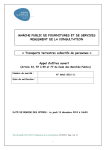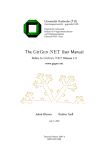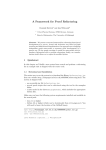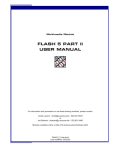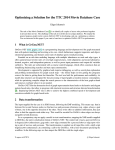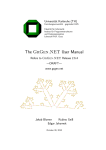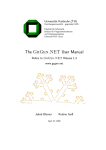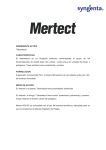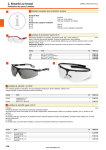Download PDF of submission 31
Transcript
A GrGen.NET solution of the Hello World Case for
the Transformation Tool Contest 2011
Sebastian Buchwald
Edgar Jakumeit
May 16, 2011
1
Introduction
We introduce the graph transformation tool GrGen.NET (www.grgen.net)
by solving the Hello World Case [1] of the Transformation Tool Contest 2011
which consists of a collection of small transformation tasks; for each task a
section is given explaining our implementation.
2
What is GrGen.NET?
GrGen.NET is an application domain neutral graph rewrite system developed at the IPD Goos of Universität Karlsruhe (TH), Germany [2]. The
feature highlights of GrGen.NET regarding practical relevance are:
Fully Featured Meta Model: GrGen.NET uses attributed and typed
multigraphs with multiple inheritance on node/edge types. Attributes
may be typed with one of several basic types, user defined enums, or
generic set, map, and array types.
Expressive Rules, Fast Execution: The expressive and easy to learn
rule specification language allows for a straightforward formulation
of even complex problems, with an optimized implementation yielding
high execution speed at modest memory consumption; outstanding
features are iterated and recursive pattern matching incl. rewriting.
Programmed Rule Application: GrGen.NET supports a high-level rule
application control language, Graph Rewrite Sequences (GRS), offering logical, sequential and iterative control plus variables and storages
for the communication of processing locations between rules.
Graphical Debugging: GrShell, GrGen.NET’s command line shell,
offers interactive execution of rules, visualising together with yComp
the current graph and the rewrite process. This way you can see what
the graph looks like at a given step of a complex transformation and
develop the next step accordingly. Or you can debug your rules.
1
3
Hello World!
The first task is to create a Greeting node with appropriate text. To solve
the task we use the GrGen rule shown in Figure 1 that creates the required
graph when being executed.
rule createHelloWorld {
replace {
greeting : helloworld_Greeting ;
eval {
greeting . _text = " Hello World " ;
}
}
}
Figure 1: HelloWorld.grg
Rules in GrGen consist of a pattern part specifying the graph pattern to
match and a nested rewrite part specifying the changes to be made. The
pattern part is built up of node and edge declarations or references with an
intuitive syntax: Nodes are declared by n:t, where n is an optional node
identifier, and t its type. An edge e with source x and target y is declared
by x -e:t-> y, whereas --> introduces an anonymous edge of type Edge.
Nodes and edges are referenced outside their declaration by n and -e->,
respectively. Attribute conditions can be given within if-clauses.
The rewrite part is specified by a replace or modify block nested within
the rule. With replace-mode, graph elements which are referenced within
the replace-block are kept, graph elements declared in the replace-block
are created, and graph elements declared in the pattern, not referenced in
the replace-part are deleted. With modify-mode, all graph elements are
kept, unless they are specified to be deleted within a delete()-statement.
Attribute recalculations can be given within an eval-statement. These and
the language elements we introduce later on are described in more detail in
the extensive GrGen.NET user manual [2].
The rule shown in Figure 1 consists of an empty pattern part and a replace part that creates a new node greeting of type helloworld Greeting
and evaluates the corresponding text attribute.
The creation rule for the extended metamodel given in Figure 2 is similar
in structure, just more voluminous. A Greeting node is created and linked
with a greetingMessage edge to a GreetingMessage node. Furthermore
it is linked with a person edge to a Person node. Then the attributes of
the message and the person are initialized to the requested values (and the
containment indices for XMI are set).
2
rule createHelloWorldExt {
replace {
greeting : Greeting ;
greeting -e : greetingMessage - > message : GreetingMessage ;
greeting -f : person - > person : Person ;
eval {
message . text = " Hello " ;
person . name = " TTC Participants " ;
e . index = 0;
f . index = 0;
}
}
}
Figure 2: HelloWorldExt.grg
The files containing the rules seen so far start with a using statement
using helloworld__ecore ;
which imports the GrGen metamodel which was generated from the given
Ecore metamodel. GrGen.NET does not support importing Ecore metamodels directly (in contrast to GXL and native GRS files). Instead we supply
an import filter generating an equivalent GrGen-specific graph model (.gm
file) from a given Ecore file by mapping classes to GrGen node classes, their
attributes to corresponding GrGen attributes, and their references to GrGen edge classes. Inheritance is transferred one-to-one, and enumerations
are mapped to GrGen enums. Class names are prefixed by the names of
the packages they are contained in to prevent name clashes; the same holds
for references which are prefixed by their node class name, and node/edge
attributes which are prefixed by an underscore. This name mangling can
be seen in Figure 1, in the following listings it was removed due to space
constraints and for the sake of readability, up to the migration chapter, from
there on it is needed again to prevent type ambiguity. Normally you want
to import an instance graph XMI adhering to the Ecore model thus adhering to the just generated equivalent GrGen graph model; if given, that one
is imported by the filter, too, serving as the host graph for the following
transformations (this can be seen in Figure 10, in this section we are only
interested in the model). The import process described is brought to life by
the import command of the GrShell.
The GrShell offers the host environment for applying the rules given in
the .grg files. The command line shell may be operated in interactive mode
or in batch mode, for the tasks of this case we use it in batch mode by
executing graph rewrite scripts, i.e. .grs files. The high level workflow of
using GrGen is shown in Figure 3
3
Figure 3: The structure of the GrGen.NET system
For the first HelloWorld task the Shell executes the script given in Figure 4.
import helloworld . ecore HelloWorld . grg
xgrs createHelloWorld
show graph ycomp
quit
Figure 4: HelloWorld.grs
The first line imports the Ecore metamodel helloworld.ecore and loads
the transformation rules declared in the rule file HelloWorld.grg. The
import process automatically generates the GrGen metamodel file helloworld ecore.gm that is used in Figure 1 and Figure 2. We then execute
an extended graph rewrite sequences that consists of one application of the
createHelloWorld rule. The graph rewrite sequences offer multiple operators for controling rule execution and parameter passing between rules,
several of them will be introduced later on, here we only execute a single
parameterless rule once. The third line is used to show the resulting graph
in the yComp tool, and finally the shell execution is quit.
Let us continue with the model-to-text transformation, Figure 5 shows
the corresponding rule. The rule matches a node of type Greeting and
the corresponding person and message. If a match is found, it creates a
new node of type StringResult and assigns the concatenation of the text
of the message and the name of the person to the result attribute. The
StringResult is then emitted into an XMI file with the rule in Figure 6,
which gets #included into the main rule file. The process is controled by
the shell script Figure 7. The 5th line is used to redirect the output of the
emit statements from stdout to the specified file.
4
# include " Emitter . gri "
rule messageToText {
greeting : Greeting ;
greeting -: greetingMessage - > message : GreetingMessage ;
greeting -: person - > person : Person ;
replace {
result : StringResult ;
eval {
result . result = message . text + " " + person . name + " ! " ;
}
}
}
Figure 5: HelloWorldExt.grg
rule emitString {
string : StringResult ;
replace {
emit ( " <? xml version =\"1.0\" encoding =\" ASCII \"? >\ n " );
// some further lines emitting XMI text not displayed
emit ( "
result =\" " + string . result + " \"/ >\ n " );
}
}
Figure 6: Emitter.gri
import helloworldext . ecore result . ecore HelloWorldExt . grg
xgrs createHelloWorldExt
show graph ycomp
xgrs messageToText
redirect emit " Model - to - text - grgen . xmi "
xgrs emitString
quit
Figure 7: HelloWorldExt.grs
5
4
Count matches with certain properties
The next task is to count the number of occurrences of certain graph structures. For each subtask the result needs to be wrapped in a node, this node
is created by an application of the rule in Figure 8. The rule creates a node
rule createIntResult : ( IntResult ) {
modify {
res : IntResult ;
eval {
res . result = 0;
}
return ( res );
}
}
Figure 8: Count.grg
of type IntResult, initializes its result attribute to 0 and then returns
the node out to the caller; it must be of type IntResult due to the output parameter declaration in the rule header with syntax : (IntResult).
(Alternatively we could create the node in the shell with the new command
which is the prefered way for creating non-trivial initial host graph.) The
node with the count has to be written to an XMI file; this is accomplished
with a text emitting rule emitInt nearly identical to the already introduced
one emitString available in the file Emitter.grg, cf. the SHARE image
for details.
The first subtask consists of counting the number of nodes on the host
graph. This is achieved by using the GrGen rule shown in Figure 9. The
rule countNode ( res : IntResult ) {
n : Node ;
modify {
eval {
res . result = res . result + 1;
}
}
}
Figure 9: Count.grg
rule increments the result attribute of the IntResult parameter by one.
To get the count of all the nodes we execute the rule for all matches in the
host graph — this can be requested by the graph rewrite sequences calling
6
the rules by enclosing the rule name in all-brackets, as can be seen on line
4 of Figure 10. Having a closer look at this line we see that the subtask is
handled by the successive application of 3 rules. The then-right operator ;>
executes the left sequence and then the right sequence, returning as result
of execution the result of the execution of the right sequence. The potential
results of sequence execution are success equaling true and failure equaling
false; a rule which matches counts as success. The IntResult returned
from the first rule is assigned to a variable res. This variable is read before
executing the second rule, its value is handed in as input argument to the
second rule, in fact to all applications of the second rule. The third rule emits
(and deletes) the IntResult (it is not handed in, instead it gets matched
in the emitInt rule). (Alternatively we could count the number number of
nodes of a certain type T with show num nodes T in the GrShell.)
import graph1 . ecore result . ecore Graph1 . xmi Count . grg
include layout . grsi
redirect emit " Count - nodes - grgen . xmi "
xgrs ( res )= createIntResult ; > [ countNode ( res )] ; > emitInt
redirect emit " Count - looping - edges - grgen . xmi "
debug xgrs ( res )= createIntResult ; > [ countLoopingEdge ( res )] ; > emitInt
# the other subtasks follow the two - line scheme given above
quit
Figure 10: Count.grs
The count looping edges subtask is interesting because in the shell script
calling it the keyword debug was prepended before the xgrs command (cf.
line 6 of Figure 10). This causes sequence execution to start in debug mode,
i.e. yComp is started visualizing the host graph and the rule matches of
interest, and the sequence is executed stepwise under user control. The
situation right after the one match available for countLoopingEdge was
found is displayed in Figure 12, the graph elements are annotated with the
names of the pattern elements which matched them, cf. Figure 11.
rule countLoopingEdge ( res : IntResult ) {
e : Edge -: src - > n : Node ;
e
-: trg - > n ;
modify {
eval {
res . result = res . result + 1;
}
}
}
Figure 11: Count.grg
7
Figure 12: Debugging the sequence calling countLoopingEdge
A major feature of yComp is its high configurability. In line 2 of Figure 10
we include a further shell script given in Figure 13, which is used to achieve
the nice layout displayed in Figure 12.
debug set layout Circular
dump add node Graph group by hidden outgoing edges
dump add node Graph group by hidden outgoing nodes
dump set node Graph color lightgrey
dump set node Node shape circle
dump set node Node color black
dump set node Node textcolor white
dump add node Node infotag name
dump set node Edge color white
Figure 13: layout.grsi
You can use one of several available layout algorithms – with hierarchic
and organic being the most useful ones, here we use circular. You can
configure for every available node or edge type in which color with what
node shape or edge style it should be shown, with what attribute values
or fixed text as element labels or tags it is to be displayed, or if it should
be shown at all. We used it to distinguish the Node nodes from the Edge
nodes. Furthermore you can configure graph nesting by registering edges
at certain nodes to define a containment hierarchy, causing the nodes to
become displayed as subgraphs containing the elements to which they are
linked by the given edges. This can be seen on lines 2 and 3 of Figure 13
8
which cause all Node nodes and all Edge nodes to be contained in the graph
node.
Figure 14 shows the rule for the optional subtask of matching all dangling
edges. It matches an Edge node and then uses an alternative to match
rule countDanglingEdge ( res : IntResult ) {
e : Edge ;
alternative {
missingTrg {
e -: src - >;
negative {
e -: trg - >;
}
modify { }
}
missingSrc {
e -: trg - >;
negative {
e -: src - >;
}
modify { }
}
}
modify {
eval {
res . result = res . result + 1;
}
}
}
Figure 14: Count.grg
either the missingSrc pattern or the missingTrg pattern. The missingTrg
pattern matches the edge to the source node and uses a negative application
condition (NAC) to ensure that the graph edge has no target node. A
negative pattern causes the matching of the enclosing pattern to fail if it is
found in the graph. Likewise, the missingSrc only matches an graph edge
with a target node, but without a source node.
The rule countIsolatedNode in Figure 15 is not matching as soon as one
of the negatives is found. The countCycle in Figure 16 is a direct encoding
of the specification, so there’s no need to go into depth here.
9
rule countIsolatedNode ( res : IntResult ) {
n : Node ;
negative {
n < -: src -;
}
negative {
n < -: trg -;
}
modify {
eval {
res . result = res . result + 1;
}
}
}
Figure 15: Count.grg
rule countCycle ( res : IntResult ) {
n1 : Node < -: src - : Edge -: trg - > n2 ;
n2 : Node < -: src - : Edge -: trg - > n3 ;
n3 : Node < -: src - : Edge -: trg - > n1 ;
modify {
eval {
res . result = res . result + 1;
}
}
}
Figure 16: Count.grg
10
5
Reverse Edges
To solve this task we need to reverse all edges. The GrGen rule shown in
Figure 17 employs retyping also known as relabeling on the GrGen edges
to accomplish this task.
rule reverseEdge {
alternative {
Src {
- src : src - >;
modify {
-: trg < src > - >;
}
}
Trg {
- trg : trg - >;
modify {
-: src < trg > - >;
}
}
}
modify { }
}
Figure 17: Reverse.grg
Retyping is specified with the syntax y:t<x>: this defines y to be a
retyped version of the original node x, retyped to the new type t; for edges
the syntax is -y:t<x>->. After applying the rule with xgrs [reverseEdge]
all source nodes are target nodes and all target nodes are source nodes. This
approach naturally reverses even dangling edges.
6
Simple Migration
To solve this task we need to migrate the graph from the graph metamodel
used in the previous tasks to another graph metamodel which is characterized by introducing a superclass GraphComponent for Node nodes and Edge
nodes. Since to the target metamodel has a similar structure, we simply use
retyping as introduced in the previous section to migrate the graph, with
the rules given in Figure 18 controled by the sequence given in Figure 19.
The name mangling from Ecore import is kept from now an as removing it
would render the types ambiguous.
11
using graph1__ecore , graph2__ecore ;
rule migrateGraph {
n : graph1_Graph ;
modify {
: graph2_Graph <n >;
}
}
rule migrateNode {
n : graph1_Node ;
modify {
migrated : graph2_Node <n >;
eval { migrated . _text = n . _name ;
}
}
rule migrateEdge {
e : graph1_Edge ;
modify {
migrated : graph2_Edge <e >;
eval { migrated . _text = " " ; }
}
}
rule migrateEdgeSrc {
-e : graph1_Edge_src - >;
modify {
- migrated : graph2_Edge_src <e > - >;
eval { migrated . index = e . index ;
}
}
rule migrateEdgeTrg {
-e : graph1_Edge_trg - >;
modify {
- migrated : graph2_Edge_trg <e > - >;
eval { migrated . index = e . index ;
}
}
rule migrateGraphEdges {
-e : graph1_Graph_edges - >;
modify {
- migrated : graph2_Graph_gcs <e > - >;
eval { migrated . index = e . index ;
}
}
rule migrateGraphNodes {
-e : graph1_Graph_nodes - >;
modify {
- migrated : graph2_Graph_gcs <e > - >;
eval { migrated . index = e . index ;
}
}
}
}
}
}
}
Figure 18: SimpleToEvolved.grg
12
xgrs migrateGraph * & migrateNode * & migrateEdge * & migrateEdgeSrc *\
& migrateEdgeTrg * & migrateGraphEdges * & migrateGraphNodes *
Figure 19: SimpleToEvolved.grs
In Figure 19 we iterate each rule until it does not match any more. This
is denoted by the postfix star * causing the preceding sequence to be iterated
as long as it succeeds. The result of a star iteration is always success (in
contrast to the plus + postfix which requires the preceding sequence to match
at least once in order to succeed), so the complete sequence linked by strict
conjunction operators & succeeds (true), too. Disjuntion | is available as
well, so are the lazy versions && and || of the operators not executing the
right sequence in case the result of the left sequence already determines the
outcome.
The solution for the second (optional) target metamodel is similar to the
first, so we only highlight the key difference: the second metamodel realizes
edges by edges and not nodes anymore. Thus model migration requires a
non-isomorphic transformation step for edges, here we use the rule shown
in Figure 20.
rule migrateEdge {
e : graph1_Edge ;
e <- graphEdge : graph1_Graph_edges -;
e -: graph1_Edge_src - > src : Node ;
e -: graph1_Edge_trg - > trg : Node ;
modify {
delete ( e );
src - migrated : graph3_Node_linksTo - > trg ;
eval {
migrated . index = graphEdge . index ;
}
}
}
Figure 20: SimpleToMoreEvolved.grg
Striving for perfection, we order the linksTo references by migrating
the graphEdge.index and employing an additional fix-up rule that ensures
that the index falls into the interval 0 . . . |linksTo| − 1. Thus the (outgoing)
edges are ordered the same way as they are ordered in the original graph.
13
7
Delete Node with Specific Name and its Incident Edges
Deleting a node with a given name is a trivial task, as can be seen in rule
given in Figure 21 using modify mode explicitely deleteing the matched
node if it bears the name searched for.
rule deleteN1 {
n : graph1_Node ;
if { n . _name == " n1 " ;}
modify {
delete ( n );
}
}
Figure 21: Delete.grg
The (optional) subtask of also deleting all incident edges is more interesting. Figure 22 shows the corresponding GrGen rule that matches the
node with the name n1 and all incident edges in an iterated fashion. The
iterated construct munches eagerly the contained pattern as long as it is
available in the graph and not yet matched; it succeeds even if the contained
pattern is not available in the graph, in contrast to the similar multiple
construct which requires the pattern to be available at least once causing
matching of the enclosing pattern to fail otherwise. Since the replace parts
are empty, all matched elements are deleted.
rule d e l e t e N 1 A n d A l l I n c i d e n t E d g e s {
n : graph1_Node ;
if { n . _name == " n1 " ;}
iterated {
n <-- e : graph1_Edge ;
replace {
}
}
replace {
}
}
Figure 22: Delete.grg
14
8
Insert Transitive Edges
The last (optional) task is to compute R ∪ R2 from a graph representation
of a relation R. The obvious way to solve this task is to provide a rule
insertTransitiveEdge that inserts a transitive edge and to apply it to
all matches by xgrs [insertTransitiveEdge]. However, this may insert
the same edge multiple times. Thus, instead we insert GrGen edges of
type Edge (anonymously with -->), then we remove multiply inserted GrGen edges and finally transform the remaining GrGen edges into edges
conforming to the metamodel: [addTransitiveEdge] && removeDuplicatedEdges* && transformEdge*
Figure 23 shows the rule that inserts the temporary transitive GrGen
edges and Figure 24 the rule that removes temporary edges inserted too
often as well as the rule that replaces the temporary edges by the edge
nodes including the links. The last one is a bit complicated due to the wish
for proper index handling.
The hom(n1,n2,n3) statement is a newly introduced construct which
allows a homomorphic matching for the contained nodes, i.e. they can be
matched to the same host graph node.
rule addTransitiveEdge {
n1 : graph1_Node ;
n2 : graph1_Node ;
n3 : graph1_Node ;
hom ( n1 , n2 , n3 );
n1 < -: graph1_Edge_src - : graph1_Edge -: graph1_Edge_trg - > n2 ;
n2 < -: graph1_Edge_src - : graph1_Edge -: graph1_Edge_trg - > n3 ;
negative {
n1 < -: graph1_Edge_src - : graph1_Edge -: graph1_Edge_trg - > n3 ;
}
modify {
n1 --> n3 ;
}
}
Figure 23: Transitive.grg
9
Conclusion
In this paper we presented a GrGen.NET solution to the Hello World! challenge of the Transformation Tool Contest 2011. We were able to solve all
tasks of the challenge, including the optional tasks, introducing the reader
alongside to a respectable amount of the functionality of GrGen.NET.
15
rule rem oveD uplic ated Edges {
n1 : graph1_Node ;
n2 : graph1_Node ;
hom ( n1 , n2 );
n1 -e : Edge - > n2 ;
n1 --> n2 ;
modify {
delete ( e );
}
}
rule transformEdge {
n1 : graph1_Node ;
n2 : graph1_Node ;
hom ( n1 , n2 );
n1 - oldEdge : Edge - > n2 ;
// Search for edge with highest index
graph : graph1_Graph -: graph1_Graph_nodes - > n1 ;
graph - graphEdge : graph1_Graph_edges - >;
negative {
graph - otherGraphEdge : graph1_Graph_edges - >;
if { otherGraphEdge . index > graphEdge . index ; }
}
modify {
delete ( oldEdge );
n1 <- src : graph1_Edge_src - e : graph1_Edge
- trg : graph1_Edge_trg - > n2 ;
graph - newGraphEdge : graph1_Graph_edges - > e ;
eval {
src . index = 0;
trg . index = 0;
newGraphEdge . index = graphEdge . index + 1;
}
}
}
Figure 24: Transitive.grg
16
References
[1] Mazanek, S.:
Hello World!
An Instructive Case for TTC.
http://is.ieis.tue.nl/staff/pvgorp/events/TTC2011/cases/
ttc2011_submission_3.pdf (2011)
[2] Blomer, J., Geiß, R., Jakumeit, E.:
http://www.grgen.net (2011)
17
The GrGen.NET User Manual.

















